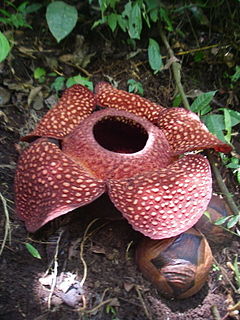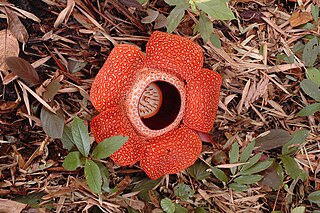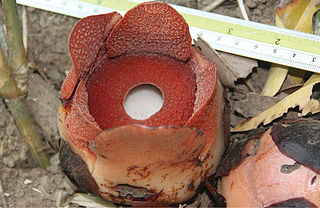
Rafflesia is a genus of parasitic flowering plants in the family Rafflesiaceae. The species have enormous flowers, the buds rising from the ground or directly from the lower stems of their host plants; one species has the largest flowers in the world. The genus contains approximately 28 species, all found in Southeast Asia, mainly in Indonesia, Malaysia, Thailand and the Philippines. For Western Europe, it was first discovered by French surgeon and naturalist Louis Deschamps in Java between 1791 and 1794, but his notes and illustrations, seized by the British in 1803, were not available to western science until 1861. The first British person to see one was Joseph Arnold in 1818, in the Indonesia rainforest in Bengkulu, Sumatra, after a Malay servant working for him discovered a flower and pointed it out to him. It was later named after Stamford Raffles, the leader of the expedition.

Baungon, officially the Municipality of Baungon, is a 2nd class municipality in the province of Bukidnon, Philippines. According to the 2020 census, it has a population of 37,111 people.

The Rafflesiaceae are a family of rare parasitic plants comprising 36 species in 3 genera found in the tropical forests of east and southeast Asia, including Rafflesia arnoldii, which has the largest flowers of all plants. The plants are endoparasites of vines in the genus Tetrastigma (Vitaceae) and lack stems, leaves, roots, and any photosynthetic tissue. They rely entirely on their host plants for both water and nutrients, and only then emerge as flowers from the roots or lower stems of the host plants.

Rafflesia keithii is a parasitic flowering plant in the genus Rafflesia endemic to Sabah in Borneo. The flowers can grow up to one metre in diameter. It is named after Henry (Harry) George Keith, former Conservator of Forests in North Borneo.

Pieter B. Pelser is a Lecturer in Plant Systematics and the curator of the herbarium at the University of Canterbury in Christchurch, New Zealand. One research interest is the evolutionary history of the tribe Senecioneae, one of the largest tribes in the largest family of flowering plants. He wrote the most recent attempt to define and delimit this tribe and its problematic founding species Senecio. He also studies insects that eat these plants (Longitarsus) which contain pyrrolizidine alkaloids and what makes them choose which plants they eat.
Rafflesia baletei is a parasitic plant species of the genus Rafflesia. It is endemic to the Philippines.
Rafflesia leonardi is a parasitic plant species of the genus Rafflesia. It is endemic to the Philippines. Rafflesia banaoana is considered to be a synonym by some sources, but is recognized as a separate species by others. R. leonardi is the fourth Rafflesia species found in Luzon and the eighth from the Philippines. It is called ngaratngat by the local Agta tribesmen.
Rafflesia lobata is a parasitic plant species of the genus Rafflesia. It is endemic to the Philippine island of Panay, particularly the mountains of Antique and Iloilo provinces. This is the second species recorded from the island of Panay. One of the most distinctive features of Rafflesia lobata is that some populations have flowers with a lobed diaphragm that opens outward. Nearly all other Rafflesia species have diaphragms that curve inward. This feature is polymorphic in R. lobata. As shown in the photos below, in some populations the diaphragm curves inward and may be 3- or 6-lobed. Note the 6-lobed flower also has 6 perigone lobes. It remains to be seen whether flower merousity has phylogenetic significance that should be taxonomically recognized. Some populations of R. manillana, such as one at Bolos Point, Cagayan Valley, Luzon, also have flowers with lobed, outwardly curving diaphragms.
Rafflesia manillana is a parasitic plant species of the genus Rafflesia. It is endemic to the Philippines.

Rafflesia schadenbergiana is a parasitic plant species of the genus Rafflesia. Known as "bó-o" to the Bagobo tribe and "kolon busaw" to the Higaonon tribe of Bukidnon, it has the largest flower among the Rafflesia species found in the Philippines with a diameter ranging from 52 to 80 centimeters. It has also the second largest flower in the genus after R. arnoldii.

Rafflesia speciosa is a parasitic plant species of the genus Rafflesia. It is endemic to the Philippine island of Panay. R. speciosa is the third Rafflesia species documented to exist in the Philippines, after R. manillana and R. schadenbergiana. It belongs to the medium-sized Rafflesia. The species was named by Julie Barcelona and Edwino Fernando.
Rafflesia patma is a parasitic plant species of the genus Rafflesia. It is only known to grow on the Indonesian island of Java, although it may have occurred on Sumatra in the past. Like the other species in its genus, this strange plant has no leaves, stems, roots or even chlorophyll, stealing all its nutrition from Tetrastigma lanceolaurium, a rainforest liana. Instead, the anatomy of this plant has devolved into mere mycelium-like strands of cells infecting the internal vascular system of its host. For general observers, the only time one might know this plant exists at all is when it flowers, and when it does, it does so impressively. The gigantic five-lobed flowers measure 30 to 60cm across, and stink with the odour of rotting flesh. This stench attracts mostly female carrion flies searching for a place to lay their eggs. When they fly inside the large pot-like structure in the middle of the flower, they find a central column inside, topped with a wart-covered disc-like plate; under the rim of this plate they find a small crevice, into which they crawl believing they have found an opening into the soft parts of a rotting body -instead, the rim is shaped in such a way that, when investigating, their backs are thus smeared with the jelly-like pollen if the Rafflesia flower is male, or it is pressed against a zone of modified stigmas if the flower is female.

Rafflesia zollingeriana is a species of flowering plant in the family Rafflesiaceae, native to Java. Of three species of Rafflesia known from Java this species has always been the most rare and restricted, it is only known from collection locales in Banyuwangi Regency, Jember Regency and Lumajang Regency, southern East Java. It was first scientifically collected in 1902 by Sijfert Hendrik Koorders on the eastern flanks of Mount Puger Watangan, a forested hill near the beach, who described it as a new species in 1918. Many decades later a flowering plant was discovered in Meru Betiri National Park, also in the Jember Regency somewhat further down the coast to the east.
Rafflesia aurantia is a member of the genus Rafflesia. It is a parasitic flowering plant endemic to Luzon Island, Philippines in the Quirino Protected Landscape. See original publication and a review of Philippine Rafflesia.

Sibalom Natural Park is a 5,511.47-hectare (13,619.1-acre) protected area in the Philippines on the island of Panay in the municipality of Sibalom, Antique. It was proclaimed a natural park on 23 April 2000. It is considered one of the last remaining lowland rainforests on Panay.

Rafflesia verrucosa was first identified and characterized during a small mammal survey of Mt. Kampalili in eastern Mindanao in 2010. R. verrucosa is the tenth species of Rafflesia found in the Philippines. Rafflesia species have rare and unusual flowers known for their large size and pungent smell. Some plant enthusiasts like Frits W. Went have gone to extreme measures to see these plants in bloom. Went detailed his search for Rafflesia saying,
"I had heard, when I was in Java many years ago, that Rafflesia were to be found on an offshore island named Nusah Kembangan. This was in 1929, when it was a penal colony for major criminals. My driver on this occasion was a convicted murderer, and my guide was serving time for cannibalism."
Julie F. Barcelona is a Filipina botanist and taxonomist working as Research Associate at University of Canterbury. She is mostly known for her research on the Philippine members of the genus Rafflesia.

Rafflesia consueloae is a parasitic plant species of the genus Rafflesia endemic to the island of Luzon in the Philippines. It is the smallest species of the genus Rafflesia.

Daniel Lee Nickrent is an American botanist, working in plant evolutionary biology, including the subdisciplines of genomics, phylogenetics, systematics, population genetics, and taxonomy. A major focus has been parasitic flowering plants, particularly of the sandalwood order (Santalales). His interest in photographic documentation and photographic databases has led to several photographic databases including Parasitic Plant Connection, Phytoimages, Plant Checklist for the Rocky Mountain National Park, and Plant Checklist for the Crab Orchard National Wildlife Refuge.

The flora of the Philippines boasts a diverse array of plant species given its location in the great Malasian flora. The Malasian Phytogeographic zone is considered to be one of the most important centers for plant diversity because of the multitude and variance of species occupying that zone. The archipelago is isolated by a continental and deep ocean.












